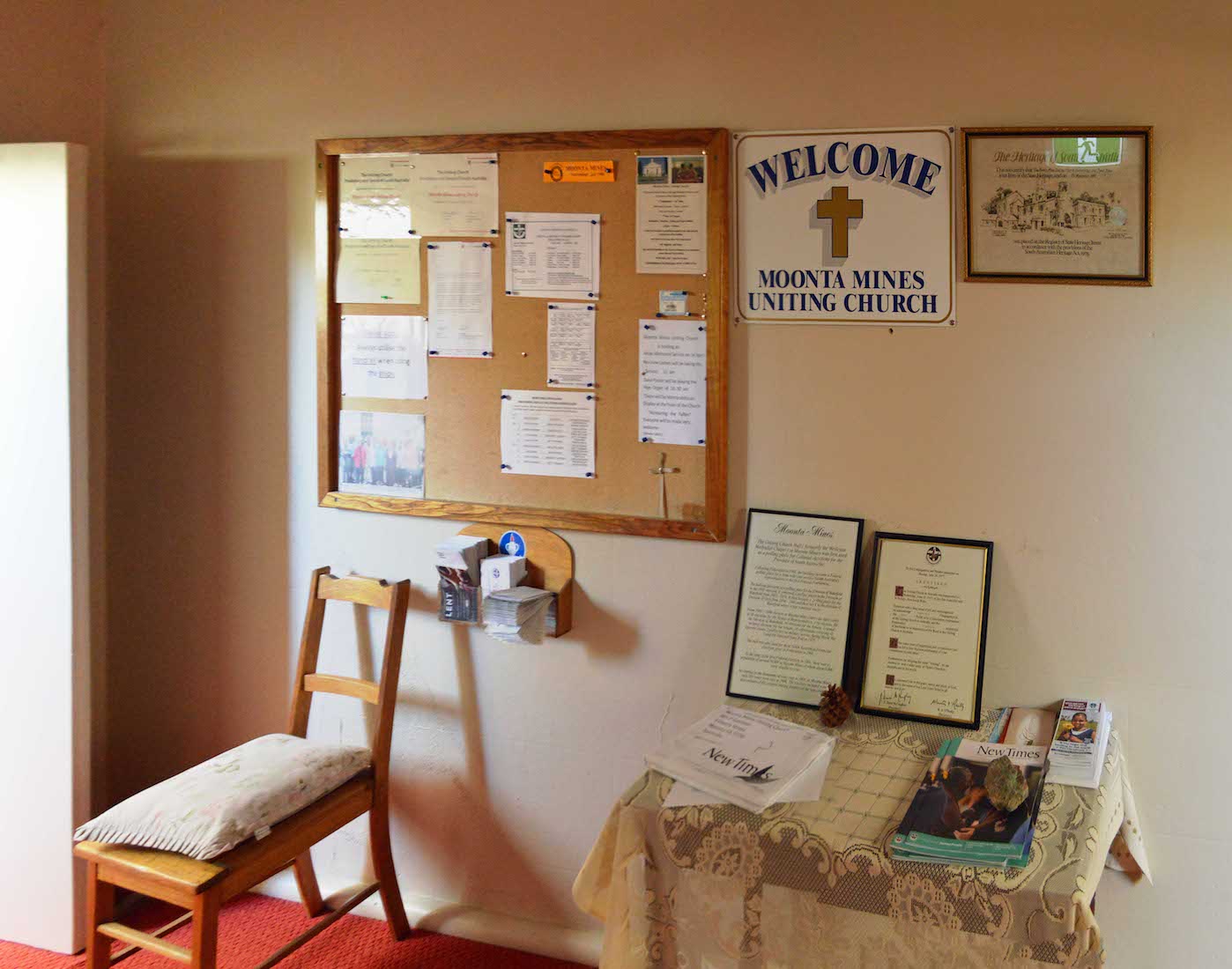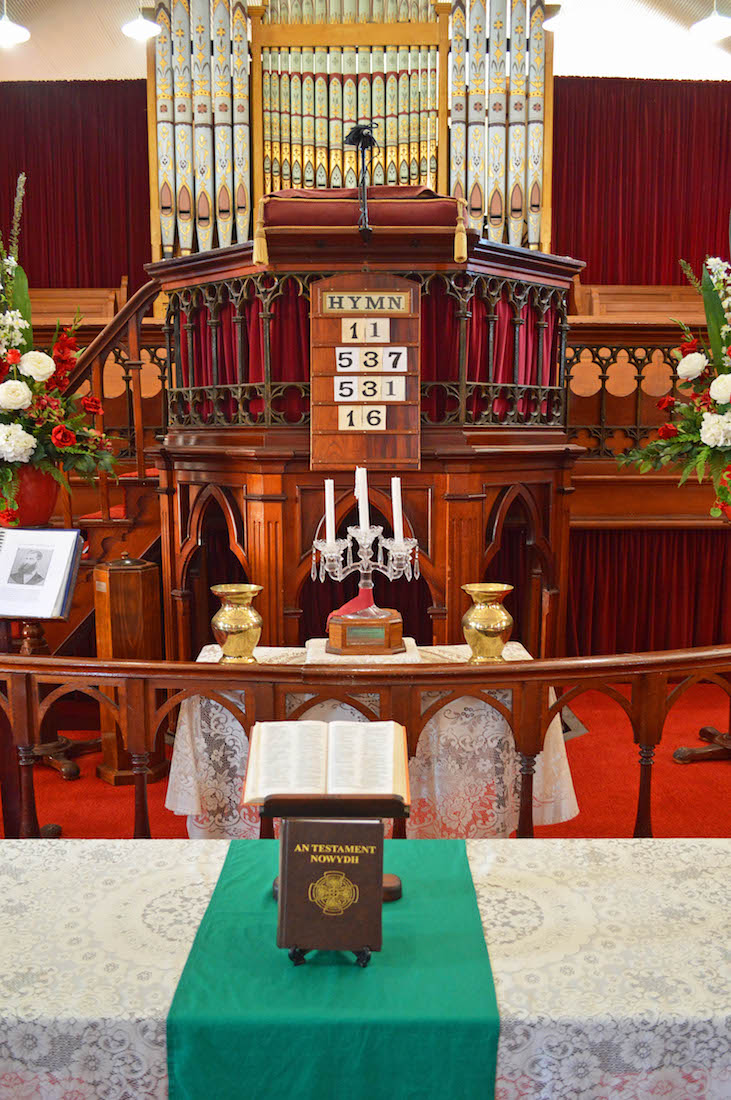
Moonta Mines is a locality at the northern end of the Yorke Peninsula, adjoining the town of Moonta. From 1861 to 1923, it was the centre of a copper mining industry that formed colonial South Australia’s largest mining enterprise. The Gothic-design Church is a short distance from the Moonta Mines Museum.
2. FRONT GABLE

The front gable bears the inscription: ‘Moonta Mines Methodist Church 1865’. ••• By 1875, the success of the Moonta mines and the mines in the surrounding area had made Moonta the second largest town in South Australia and the largest copper region in the British Empire. Moonta Mines itself had a population of 5,000 residents.
3. WALL PLAQUE
This sesquicentenary plaque is by the main West doors. ••• The Moonta Mines Uniting Church, formerly the Wesleyan Methodist Chapel, celebrated its 150th anniversary on Sunday 6th December 2015. There was a parade from the Moonta Mines Museum and an afternoon service. The program featured performances by Sing Australia and the Kadina Wallaroo Moonta Band.
4. MUD SCRAPER
An old metal scraper for removing mud from boots stands by the West doors. ••• The Church was built during the mining boom in this area in 1865. It was a replica of the Wesleyan Chapel in Truro, Cornwall, and seated 750 people. However, the number of worshippers greatly exceeded this number so in 1872, a gallery to hold a further 500 was installed, making the seating capacity 1250.
5. FRONT WALL SIGN
The old sign by the front wall has text: ‘Moonta Mines Uniting Church “Wesleyan Methodist” Founded 1865’. Underneath is the text ‘Eglos’ – Cornish for ‘Church’. ••• In 1872, Moonta was the largest South Australian town outside Adelaide, and this was the largest South Australian church outside Adelaide at the time.
6. NORTH WALL
We walk around the Church in a clockwise direction. This is the North wall with the entry porch at the far end. ••• In those early days two services were held each Sunday with full congregations. On a lighter note, in the old Church Minute Books, the following is recorded: "Some senior members of the Church Trust must go into the gallery and control the boys". Times never change!
7. NORTH PORCH ENTRANCE
This is the North porch entrance. We shall return to this entry. Note the steps beyond the porch: an emergency exit through this window from the inside balcony. ••• In 1888 a magnificent gold and turquoise painted pipe organ with 610 pipes was installed at a cost of £258 ($516). The boys who pumped the organ bellows in the early days sat behind a large curtain.
8. EAST WALL
We come to the back East wall. Here we see an added vestry to which is attached a bell tower with a rusty old bell at the top. ••• The names of the organ boys were scratched or pencilled on the organ panelling, and are still there today. The boys received 1/- (10 cents) a week for these duties. Quite often, to the consternation of the organist, they would fall asleep during the sermon.
9. SOUTHEAST CORNER VIEW
We observe the South porch at left extending from the South nave wall, and the fire escape steps. ••• The pump handle operating the organ bellows is still there and was used until 1960 when a motor was installed. After more than 100 years, the organ required a major overhaul and a quote of $45,000 for the refurbishment was obtained.
10. LOOKING ALONG THE SOUTH WALL
With a grant of $39,000 from the National Estate in Canberra the overhaul was carried out magnificently by Mr Leith Jacob and his staff, leaving the paintwork untouched. Today, the congregation is small and comprises mainly seniors. Some difficulties are being experienced in securing sufficient volunteers to maintain the opening hours.
11. ENTRY NOTICE
This notice by the North entry gives information about visiting the Church.
13. NORTH NAVE WALL
There are three plaques on the North wall of the nave. We notice the many fans too: it gets hot here in summer!
14. NORTH WALL PLAQUE
The first plaque commemorates the inaugural service of the Copper Triangle Parish. This is a parish comprising the towns of Moonta, Kadina and Wallaroo. The service was held in this Church on 9th February 1992, with speaker Rev Neale Michael.
15. HANCOCK MEMORIAL
The Hancock memorial remembers Henry Lipson Hancock (1867 – 1935) of Moonta Mines. For 19 years he was general manager of the Wallaroo and Moonta Mining and Smelting Company. He was a member of the Advisory Council of Education. He was an enthusiast for Sunday school work, and established a graded school at Moonta Mines which became a model for many churches throughout the Commonwealth.
16. SUNDAY SCHOOL PLAQUE
This plaque dated 2nd November 1980, commemorates the official celebration of the Uniting Church in Australia, Synod of South Australia, marking the 200th anniversary of the Sunday School Movement begun by Robert Raikes in England.
17. WALL BY ENTRY
By the entry door there is a general notice board and a utility table. Of interest on the table is a framed document acknowledging the participation of the Moonta Mines Church in the amalgamation of churches to form the Uniting Church in 1977.
18. COMMUNION TABLE
An important focus in the Uniting Church is the communion table. It is from here that the communion elements of bread and wine, representing the body and blood of Christ, would be distributed at a Sunday service. However, we do notice a kneeling rail behind ... .
19. PULPIT
Another important and traditional focus is the pulpit. In Bristol in 1739 John Wesley began preaching to crowds of working class men and women in the outdoors. This 'field preaching' became a key feature of the Revival, when thousands came to hear Wesley preach up and down the country.



















